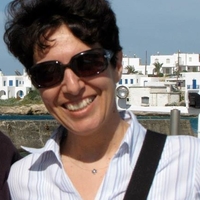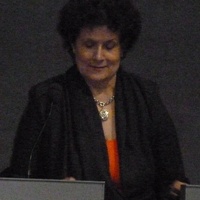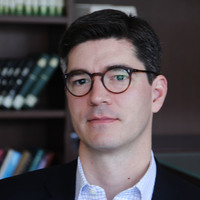
Maria Parani
Phone: +357 22893565
Address: University of Cyprus
Department of History and Archaeology / Archaeological Research Unit
P.O. Box 20537
Nicosia 1678
Cyprus
Address: University of Cyprus
Department of History and Archaeology / Archaeological Research Unit
P.O. Box 20537
Nicosia 1678
Cyprus
less
Related Authors
Bente Kiilerich
University of Bergen
Renata Holod
University of Pennsylvania
Warren Woodfin
Queens College of the City University of New York
Anthony Kaldellis
University of Chicago
Matthew Canepa
University of California, Irvine
Linda Safran
University of Toronto
Tatjana Vuleta (Татјана Вулета)
University of Arts in Belgrade, Faculty of Applied Arts
Anna C Kelley
University of St Andrews
Kriszta Kotsis
University of Puget Sound
InterestsView All (7)










Uploads
Papers by Maria Parani
Keywords: painted ornament, disk symbolism, cross-and-star pattern, Islamic glazed tiles, early Komnenian painting, Koutsovendēs Monastery, Byzantine Cyprus
asset or commodity for their owners and users. The second section focuses on metalwork, a facet of Byzantine material culture which is very well represented in the database, and surveys the documents’ information on its various daily uses as well as on types of materials and techniques. The exceptional usefulness of ByzAD in elucidating the meaning of obscure terms is shown in the discussion of certain technical words related to metalwork. The contribution of ByzAD
in the disambiguation of Byzantine technical vocabulary is further illustrated in the third and final section, where all the difficult or rare technical terms that are encountered in ByzAD are collected and listed in alphabetical order, accompanied by a brief definition and commentary.
owned and used by Christians and discusses their functions in daily, funerary, ecclesiastical, and other ritual contexts. Continuities with and departures from earlier Roman practices are highlighted, while the emergence of a specifically Christian decorative repertory is associated both with the wish of early Christians to express their distinct religious identity in material terms and with the gradual elaboration of a Christian symbolism of light. The need for more focused, contextualized studies of lamps within the framework of Christian archaeology remains a desideratum for future research.
Series: Sources for Byzantine Art History 3
In this book the beauty and meaning of Byzantine art and its aesthetics are for the first time made accessible through the original sources. More than 150 medieval texts are translated from nine medieval languages into English, with commentaries from over seventy leading scholars. These include theories of art, discussions of patronage and understandings of iconography, practical recipes for artistic supplies, expressions of devotion, and descriptions of cities. The volume reveals the cultural plurality and the interconnectivity of medieval Europe and the Mediterranean from the late eleventh to the early fourteenth centuries. The first part uncovers salient aspects of Byzantine artistic production and its aesthetic reception, while the second puts a spotlight on particular ways of expressing admiration and of interpreting of the visual.
Keywords: painted ornament, disk symbolism, cross-and-star pattern, Islamic glazed tiles, early Komnenian painting, Koutsovendēs Monastery, Byzantine Cyprus
asset or commodity for their owners and users. The second section focuses on metalwork, a facet of Byzantine material culture which is very well represented in the database, and surveys the documents’ information on its various daily uses as well as on types of materials and techniques. The exceptional usefulness of ByzAD in elucidating the meaning of obscure terms is shown in the discussion of certain technical words related to metalwork. The contribution of ByzAD
in the disambiguation of Byzantine technical vocabulary is further illustrated in the third and final section, where all the difficult or rare technical terms that are encountered in ByzAD are collected and listed in alphabetical order, accompanied by a brief definition and commentary.
owned and used by Christians and discusses their functions in daily, funerary, ecclesiastical, and other ritual contexts. Continuities with and departures from earlier Roman practices are highlighted, while the emergence of a specifically Christian decorative repertory is associated both with the wish of early Christians to express their distinct religious identity in material terms and with the gradual elaboration of a Christian symbolism of light. The need for more focused, contextualized studies of lamps within the framework of Christian archaeology remains a desideratum for future research.
Series: Sources for Byzantine Art History 3
In this book the beauty and meaning of Byzantine art and its aesthetics are for the first time made accessible through the original sources. More than 150 medieval texts are translated from nine medieval languages into English, with commentaries from over seventy leading scholars. These include theories of art, discussions of patronage and understandings of iconography, practical recipes for artistic supplies, expressions of devotion, and descriptions of cities. The volume reveals the cultural plurality and the interconnectivity of medieval Europe and the Mediterranean from the late eleventh to the early fourteenth centuries. The first part uncovers salient aspects of Byzantine artistic production and its aesthetic reception, while the second puts a spotlight on particular ways of expressing admiration and of interpreting of the visual.
The seventeen essays in this volume offer a snapshot of the most recent scholarship on the art, archaeology, and material culture of Cyprus under Latin rule. Established and emerging art historians and archaeologists, both trained Byzantinists and specialists of European medieval art, come together to re-appraise the field in the light of current research, put forward new evidence from fresh archival, archaeological, or archaeometric research, and propose novel interpretations destined to blaze exciting new pathways to future study of this fascinating body of material.